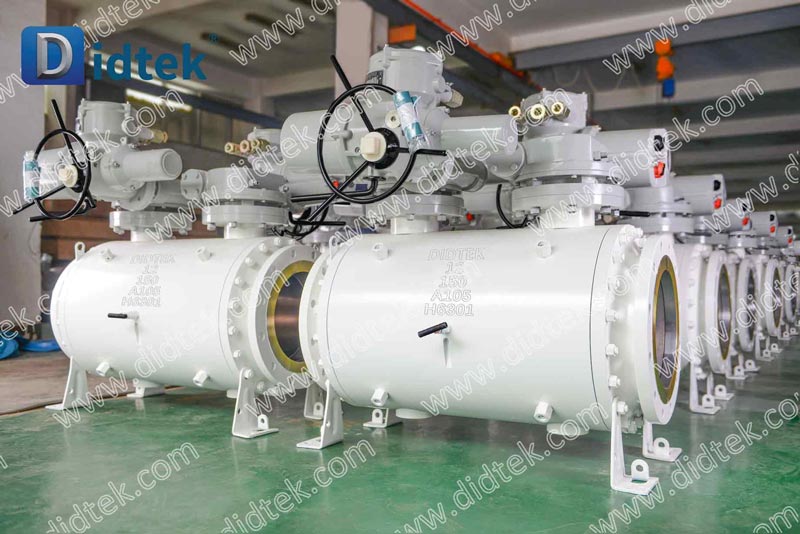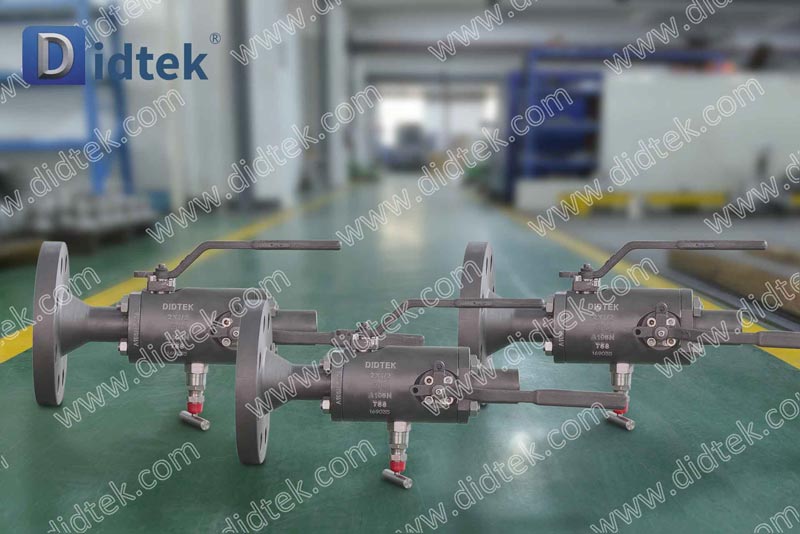Double blocking double discharge valve abbreviated DBB valve. It consists of two common ball valves connected by a common inlet end. Double blocking double discharge valve is a kind of alternative to conventional valves between a variety of connections; As the name suggests, it is a double - stop drain ball valve. The difference between this DBB valve and conventional DBB valve is that it can effectively overcome leakage during system operation, and can be quickly closed and easy to discharge. This DBB ball valve is a modern form of valve commonly used in the market today.
The two institutions formally describe the double blocking valve and the bleed valve in different terms.
As defined by API 6D, a double-plugged exhaust valve (DBB) is a "single valve with two seat surfaces that, in the closed position, provides a seal of pressure from both ends of the valve through an exhaust/exhaust valve in the cavity between the seat surfaces." According to the 2008 instructions, the valve does not have a positive dual isolation when only one side is under pressure.
OSHA defines a DBB valve as "closing a line, duct, or duct by closing, locking, or marking two inline valves, and by opening, locking, or marking a discharge or exhaust valve between two closing valves."
Double blocking double discharge valve abbreviated DBB valve. It consists of two common ball valves connected by a common inlet end. Double blocking double discharge valve is a kind of alternative to conventional valves between a variety of connections; As the name suggests, it is a double - stop drain ball valve. The difference between this DBB valve and conventional DBB valve is that it can effectively overcome leakage during system operation, and can be quickly closed and easy to discharge. This DBB ball valve is a modern form of valve commonly used in the market today.
The two institutions formally describe the double blocking valve and the bleed valve in different terms.
As defined by API 6D, a double-plugged exhaust valve (DBB) is a "single valve with two seat surfaces that, in the closed position, provides a seal of pressure from both ends of the valve through an exhaust/exhaust valve in the cavity between the seat surfaces." According to the 2008 instructions, the valve does not have a positive dual isolation when only one side is under pressure.
OSHA defines a DBB valve as "closing a line, duct, or duct by closing, locking, or marking two inline valves, and by opening, locking, or marking a discharge or exhaust valve between two closing valves."
Double blocking double discharge valve abbreviated DBB valve. It consists of two common ball valves connected by a common inlet end. Double blocking double discharge valve is a kind of alternative to conventional valves between a variety of connections; As the name suggests, it is a double - stop drain ball valve. The difference between this DBB valve and conventional DBB valve is that it can effectively overcome leakage during system operation, and can be quickly closed and easy to discharge. This DBB ball valve is a modern form of valve commonly used in the market today.
The two institutions formally describe the double blocking valve and the bleed valve in different terms.
As defined by API 6D, a double-plugged exhaust valve (DBB) is a "single valve with two seat surfaces that, in the closed position, provides a seal of pressure from both ends of the valve through an exhaust/exhaust valve in the cavity between the seat surfaces." According to the 2008 instructions, the valve does not have a positive dual isolation when only one side is under pressure.
OSHA defines a DBB valve as "closing a line, duct, or duct by closing, locking, or marking two inline valves, and by opening, locking, or marking a discharge or exhaust valve between two closing valves."

Double block and bleed valve classification
DBB valves are classified by their body structure into two main types:
Modular or Split Body Type DBB Valve – The main feature of this design is that it has two balls in one valve to ensure greater safety. A drain needle valve is located between the two balls on the Double Block & Bleed valve. This allows the valve to be drained and the pressure to be reset to zero. Instrumentation and piping all benefit from the modular form, three-piece body construction. Instrumentation valves range in size from 1 inch to 3 inches; piping valves range in size from 1 inch to 24 inches. API 3.000 to API 10.000 in all pressure class scores from 150 to 2500 lbs.
Integral DBB Valves – These valves are used in the instrumentation industry and come in a variety of designs to meet a variety of needs, including flange to flange, flange to the thread, injection, and sampling, and ball and needle types. A drain needle valve is located between the two balls on the Integral Double Block & Bleed valve. This allows the valve to be drained and the pressure to be reset to zero.
Features and Benefits of DBB Valve
Double Block and Bleed valves have been developed to substitute the process of bolting the individual valves together to provide dual insulation.
This new model provides excellent savings in weight, space, and installation time, particularly for insulation in the instrument or instrument cage. These weight savings will amount to up to 60% and tests have shown that a time savings of 70% on installation is also possible. The biggest benefits must be seen, however, in reducing the leakage pathways into the environment, thus reducing the possibility of possible dangers.
Dual isolation is an essential requirement when maintenance is performed downstream of the first isolation valve. Cavity venting is given by either a ball or a globe vent valve such that the compressed pressure between the two isolation valves is vented safely.
These valves have also grown to incorporate the role of chemical injection and sampling points. In-built control valves are also incorporated into these valves.

Application of Double Block and Bleed Valve
DBB valves are used where critical sealing is necessary to make sure no leakage occurs. Both valves can operate in various applications and industries, such as the Natural Gas industry, petrochemical, transmission and storage, industrial processes for natural gas, main-line and multi-purpose valves in liquid pipelines, and transmission lines of refined materials.
The demand for meters calibration is another application where the DBB valve is used. Each valve closed to the meter device must be tightly sealed. Even a minor leak causes errors in meter calibration and the inaccurate meter factor remains until the next proven procedure and large sums are required. Choosing the right DBB or DIB valve tested for API will help ensure the calibration is accurate almost every time.
Difference between DBB and DIB
API describes Double Isolation & Block Valve, DIB as a “single valve with two seating surfaces, each of which, in the closed position, provides a seal against pressure from a single source, with a means of venting/bleeding the cavity between the seating surfaces.” This feature can be provided in one or both directions.
The main difference is that the double block and bleed valve protects against pressure from either side of the valve while the double isolation and bleed valve offers additional seal against pressure from just one side. It is necessary to use the DIB valve instead of the DBB valve in applications requiring an external pressure barrier to be sealed separately from the main pressure barrier. This is critical to meet such operational safety standards or depending on the type of the operation, such as low leakage tolerance of fluid cleanliness.
There are normally two unidirectional self-relieving seats with a DBB valve. These seats do not depend on an external pressure relief system. On the other hand, the DIB valve uses one or two bi-directional seats. The valve allows dual isolation from the pressure at both ends of the valve, but cannot ease the pressure of the body cavity past the seats. DIB valves need an external relief mechanism to ease the build-up of pressure.
Both valves could protect in both the upstream and downstream directions, even in high-pressure or high-temperature conditions. Isolation is critical in situations where leakage through the valve can have significant implications. Once the fluid is sealed, the bleed system may drain the area between the two valves or two seating surfaces. This is critical for maintenance and integrity checks in cases where leakage can be tracked.
How to select the right DBB valve for your need
The main factors in choosing the right dual blocking and draining valve for your application are:
· The nature of the application will determine the type of DBB valve you need. For example, if the integrity of the system needs to be protected while a section of pipe is being repaired, the DBB valve can be used to do the job. Two gate valves can block the ongoing flow of water. A ball valve can drain fluid from a blocked pipe until it can be repaired.
· The type of DBB valve you choose depends on the type of medium you want to control. Viscous liquids and dense gases require full-hole ball valves, globe valves, or gate valves as blocking valves. Needle valves are often used as drain valves. Corrosive media may involve stainless steel DBB valves that have been secured to block media without causing any harm.
· The temperature and pressure conditions you operate will determine the type of DBB valve you need. High pressure and high temperature operations will include the use of antistatic ball valves as block valves. These ball valves are not affected by pressure fluctuations or vibrations, making them safe for use in sensitive operations. A single DBB gate valve with an adjustable wedge and body vent valve can be used for low pressure






